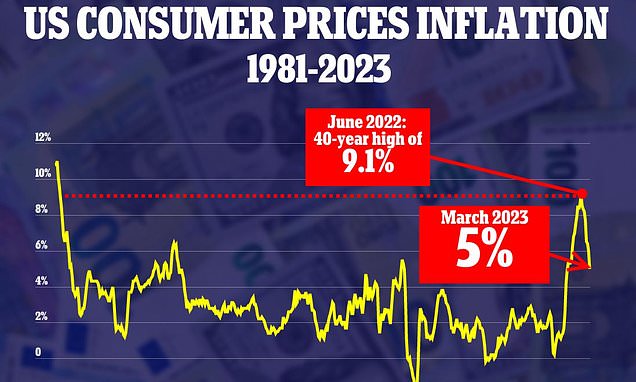Digital Zeitgeist – At 5% American Inflation Is At Its Lowest Level Since 2021
According to official data, US annual inflation decreased to 5% last month, marking the slowest rate of price rises since they first started to rise in 2021.
The price of a basket of goods and services is measured monthly by the consumer price index (CPI), which indicated a slight reduction in the rate over the previous year in March. The annual inflation rate was 6.0% in February, a sharp fall from its peak of 9.1% in June.
Core inflation, which excludes volatile energy and food costs, has stayed stable, indicating that comparisons to the sky-high petrol prices a year ago, at the start of Russia’s invasion of Ukraine, may be to blame for the slowing rate. Core inflation in March was 5.6% over the previous year, up from 5.5% in February.
With a 0.4% increase over the previous month and an 8.2% increase over the previous year, housing has been the main driver of price rises over the past few months. The increase in housing costs cancels out the negative effects that falling energy costs, which fell 6.4% over the last year, had on the inflation rate as a whole. March saw no increases in food prices from the previous month.
Despite the general cooling, Federal Reserve policymakers, who have been contemplating more interest rate rises in their relentless push to cut inflation, are unlikely to be persuaded by the widely watched inflation data.
Economists anticipate the Fed to keep raising interest rates despite the fact that general inflation is trending downward and despite the instability that higher rates would cause for the economy. In response to the failure of Silicon Valley Bank, the Federal Reserve raised interest rates by one-quarter point in March, bringing them to a range of 4.75% to 5%. (SVB). Throughout the last year, the Fed has raised interest rates nine times in a row, each time by a quarter point to three-quarters of a point.
Fed chairman Jerome Powell, stated in March that the institution was closely observing the effects of SVB’s demise but was steadfast in its commitment to bringing inflation down to a target objective of 2%.
“We’re looking at what’s happening among the banks and asking: ‘Is there going to be some tightening in credit conditions?’ And then we’re thinking about that as effectively doing the same thing that rate hikes do. So in a way, that substitutes for rate hikes,” Powell said. “At the end of the day, we will do enough to bring inflation down to 2%. No one should doubt that.”
The employment report from the previous month also indicated hints of ongoing job gains, another crucial data point the Fed examines to decide whether to raise interest rates, in addition to the CPI data from March indicating persistent core inflation.
While still a gain overall, the 236,000 jobs added to the labour force in March indicate a minor softening of the market. At 3.5%, the unemployment rate decreased by 0.1%. The numbers indicate that the employment market is slowing down gradually, which the Fed will likely interpret as evidence that the economy can withstand further interest rate increases even as worries about a recession loom.
The Fed’s next board meeting, on Tuesday, May 2, is when it will announce any forthcoming interest rate increases.
online sources: theguardian.com, federalreserve.gov

